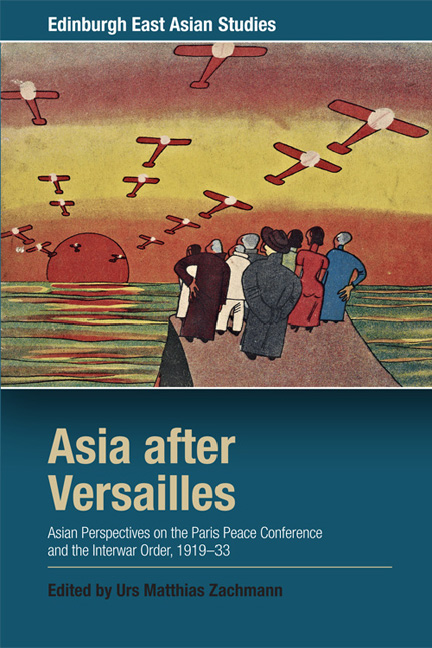 Asia after Versailles
Asia after Versailles Book contents
- Frontmatter
- Contents
- List of Illustrations
- Notes on Contributors
- Acknowledgments
- Introduction: Asia After Versailles
- Part I
- Part II
- 4 A Cultural History of Diplomacy: Reassessing the Japanese ‘Performance’ at the Paris Peace Conference
- 5 India's Freedom and the League of Nations: Public Debates 1919–33
- 6 Dashed Hopes: Japanese Buddhist Perspectives on the Paris Peace Conference
- 7 Particularism and Universalism in the New Nationalism of Post-Versailles Japan
- 8 Versailles and the Fate of Chinese Internationalism: Reassessing the Anarchist Case
- 9 The Impact of Versailles on Chinese Nationalism as Reflected in Shanghai Graphic and Urban Culture, 1919–31
- Index
7 - Particularism and Universalism in the New Nationalism of Post-Versailles Japan
from Part II
Published online by Cambridge University Press: 22 December 2017
- Frontmatter
- Contents
- List of Illustrations
- Notes on Contributors
- Acknowledgments
- Introduction: Asia After Versailles
- Part I
- Part II
- 4 A Cultural History of Diplomacy: Reassessing the Japanese ‘Performance’ at the Paris Peace Conference
- 5 India's Freedom and the League of Nations: Public Debates 1919–33
- 6 Dashed Hopes: Japanese Buddhist Perspectives on the Paris Peace Conference
- 7 Particularism and Universalism in the New Nationalism of Post-Versailles Japan
- 8 Versailles and the Fate of Chinese Internationalism: Reassessing the Anarchist Case
- 9 The Impact of Versailles on Chinese Nationalism as Reflected in Shanghai Graphic and Urban Culture, 1919–31
- Index
Summary
This chapter explores the competing tensions between new forms of particularism and universalism and how they influenced the way nationalism was understood in Japan after the Versailles Treaty. Both tendencies, while competing with and, in certain respects, symbiotically reinforcing each other, developed in a new postwar context in which ideas and ideals were given enhanced status in political life. This greater opening to the impact of ideals was connected to a sense of disillusionment with the state as the key structure of political life and to a longing for a more reliable institutional resolution to the new challenges in national and international affairs. The right resolution of these challenges, it was hoped, would end war for all times and usher in an unprecedented era of world peace. It was a heady time.
The search for forms of political life took two paths, largely, although not always, oriented in different directions: one headed down the road of internationalism, even as there was much debate as to what this ‘internationalism’ really meant. The other was a reappraisal of particularism, sometimes heralded as a new logic of populist democracy, at others times decried as the foundation for antidemocratic movements, as both emerged almost immediately after the end of the First World War. The intersections and divergences of particularism and universalism, especially as they influenced the politics of nationalism, shaped much of the dynamics of the political, social and intellectual life in Japan and elsewhere in the years that followed Versailles.
One useful place to begin unpacking these rival movements, and especially how they were experienced in postwar Japan, is with H. D. Harootunian's thesis of the bunmei (civilisation) of Meiji giving way to the bunka (culture) of the Taisho period (although one should note that Harootunian traces the origins of Taisho culturalism to late nineteenth-century intellectuals like Takayama Chogyū and Kitamura Tōkoku). Harootunian sees a shift around the beginning of the Taisho period from overtly political concerns to internalised cultural ones. My argument builds on Harootunian's insight into the relationship between civilisation and culture, with an emphasis on these two polarities not as exclusive opposites that force one to choose between them, but as a relationship which is constantly being remade in history.
- Type
- Chapter
- Information
- Asia after VersaillesAsian Perspectives on the Paris Peace Conference and the Interwar Order, 1919-33, pp. 175 - 196Publisher: Edinburgh University PressPrint publication year: 2017
